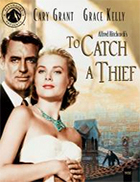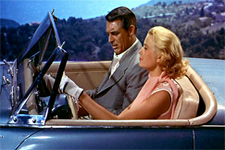| Director: Alfred Hitchcock | | Screenplay: John Michael Hayes (based on the novel by David Dodge) | | Stars: Cary Grant (John Robie), Grace Kelly (Francie Stevens), Jessie Royce Landis (Jessie Stevens), John Williams (H. H. Hughson), Charles Vanel (Bertani), Brigitte Auber (Danielle Foussard), Jean Martinelli (Foussard), Georgette Anys (Germaine) | | MPAA Rating: PG | | Year of Release: 1955 | | Country: U.S. |  |
|  To Catch a Thief has never been one of Hitchcock’s greatest films. Described by Donald Spoto in The Art of Alfred Hitchcock as “a creampuff of a movie with a little suspense at the end” and by Hitchcock himself as “a lightweight story,” it was one of Hitch’s thriller-comedies, although it is more romantic than suspenseful, better known for its clever double entendres (both verbal and visual) than its hair-raising moments. In the third of his four collaborations with Hitchcock, the reliably dapper Cary Grant stars as John Robie, a former master jewel thief who fought in the French Resistance during World War II and is now enjoying a comfortably secluded and private existence in the south of France (he’s obviously spent a great deal of time in the sun as he is tanned to a deep, almost unnatural bronze). However, when a rash of high-profile jewel thefts begin ravaging the Côte d’Azur, the police focus in on him because the robberies fit his M.O. Robie insists that he is innocent (although Hitchcock slyly keeps the idea open that it might be him all along) and becomes determined to nail the jewel thief himself in order to clear his name. Thus, the film fits neatly into Hitchcock’s two favorite scenarios: the innocent man wrongly accused and the double-chase, in which the wrongly accused hero is pursued by both the real villain and the police (Grant would find himself in a similar position a few years later in Hitchcock’s superior North by Northwest [1959]). Yet, unlike most of Hitchcock’s films, in which the villain is usually obvious from the start, To Catch a Thief is a genuine whodunit, and the narrative is built around unmasking the real jewel thief at the end. However, in many ways, the entire jewel thievery plot is nothing more than Hitchcock’s favorite cinematic device, the macguffin, that thing you think is so important but is ultimately irrelevant to the film’s real goal. In To Catch a Thief, the real story is not about crime, but about the growing romance between Robie and Francie Stevens (Grace Kelly, in her third and final appearance in a Hitchcock film), a spoiled American heiress on vacation who sets her sights on Robie mostly because he doesn’t roll over for her as so many men have in the past. Francie is fascinated by Robie’s rouge charm, and the fact that he was (or maybe still is) a master thief thrills her to no end. Thus, the film’s title takes on a double meaning, as Robie is trying to catch the jewel thief while Francie tries to catch him. While not a great film, To Catch a Thief has plenty to recommend about it. The Oscar-winning cinematography by Robert Burk, who shot 12 of Hitch’s films, including The Birds (1963) and Marnie (1964), is absolutely gorgeous in all its Technicolor glory, giving the posh hotels and French blue skies just the right hint of decadence. Unlike so many of Hitchcock’s films, at least half of To Catch a Thief was actually shot on location, so you get a real sense of the spacious glamour of the south of France. Speaking of glamour, any film that pairs Cary Grant and Grace Kelly is worth seeing at least once, and the infamous seduction scene in Francie’s darkened hotel room is one of Hitchcock’s cleverest and sexiest moments, unsubtle though it is. With fireworks exploding in the background, Francie entices Robie with the diamond necklace around her neck, although every line she says can be read in relation to her body, which is the real jewel (“Hold them,” she says at one point, referring to either her breasts or the diamonds or both). It is all done in a knowing, cheeky fashion, which was done as much to placate the Production Code Administration as it was to remind the audience that, in the end, this is all in fun. And that’s the word that best sums up To Catch a Thief—“fun.” It is not deep or socially relevant in the way some of Hitch’s films are, and it certainly didn’t break any new ground cinematically. It does make for a diverting good time, though, and one can’t entirely fault Hitchcock for wanting to rest on his laurels every once in a while. | To Catch a Thief “Paramount Presents” Edition Blu-ray | | | Aspect Ratio | 1.85:1 | | Audio | English Dolby True HD 5.1 surround French Dolby Digital 2.0 monaural Spanish Dolby Digital 2.0 monaural German Dolby Digital 2.0 monaural Italian Dolby Digital 2.0 monaural Japanese Dolby Digital 2.0 monaural | | Subtitles | English, English SDH, French, German, Italian, Japanese, Spanish, Danish, Dutch, Finnish, Norwegian, Swedish | | Supplements | Audio commentary by film scholar Drew Caspar“Filmmaker Focus: Leonard Maltin on To Catch a Thief” featurette“Behind the Gates: Cary Grant and Grace Kelly” featuretteOriginal theatrical trailer | | Distributor | Paramount Home Entertainment | | SRP | $29.98 | | Release Date | April 21, 2020 | | | COMMENTS | | To Catch a Thief is one of the first releases in the new “Paramount Presents” line, and it has been given a new 4K transfer that generally looks pretty great. To Catch a Thief was one of the first films shot using Paramount’s VistaVision widescreen process, which used special 35mm film that was pulled through the camera horizontally, thus creating an image size more than two and a half times that of regular 35mm. VistaVision films were known for having striking clarity and detail, which we definitely see in the new 4K transfer. While there are some shifts in terms of sharpness in some scenes, mostly resulting from the process and rear-projection shots, the overall image is very clear and sharp. With this Blu-Ray we can retrieve some sense of what American audiences must have felt when watching the film’s pristine, glistening wide shots of the Côte d’Azur, as this was one of the first Hollywood films shot on location there. Color is excellent throughout, with a good, solid representation of the deep hues of the Technicolor dye transfer process. This is particularly noticeable in the exterior shots along the beach and also in the hotel room scene with the fireworks. However, that being said, this transfer will create plenty of controversy. Hitchcock aficionados will immediately notice that the transfer has been hit with some fairly heavy digital noise reduction, which has smoothed out the image and removed quite a bit of film grain and texture. The image is clean and bright (quite a bit brighter than Paramount’s 2012 Blu-ray) and maintains strong detail, especially in the close-ups, but it definitely has an unnaturally smooth appearance that does not comport with the look of a film shot in the mid-1950s. And that brings us to the issue of color, which in some instances has been radically changed from previous editions. You will immediately notice a drastic color change in the nighttime scenes, which used to have a decidedly green tint to them, but are now midnight blue. This was clearly a very conscious decision to alter the color timing, and some have speculated that it was done in accordance with the look that Hitchcock told François Truffaut he was trying to achieve, but didn’t. So, in a sense, one could argue that the different color palette is true to Hitchcock’s intentions, even if it does not reflect the way the film looked theatrically in 1955 nor in any of its subsequent home video releases. Much less controversial will be the newly remixed Dolby True HD 5.1 surround soundtrack (the previous Blu-ray offered the original two-channel stereo and monaural tracks, so if you’re an audio purist, you’ll want to hang onto that disc for that reason, as well). The six-channel mix is subtly effective in opening up the musical score and some of the sound effects, with particularly good directionality in the driving scenes, but never in a way that sounds unnatural or forced. It is truly unfortunate, though, that Paramount has left out so many of the supplements that appeared on the previous editions, including the 2009 “Centennial Collection” DVD and the 2012 Blu-ray. In fact, almost all of the supplements that appeared on the previous Blu-ray edition, including eight featurettes about various aspects of the film’s production and reception, have been dropped. The only extras that have been retained are “Behind the Gates: Cary Grant and Grace Kelly,” a 6-minute featurette that focuses on the film’s legendary stars; the original theatrical trailer; and the 2009 audio commentary by film scholar Drew Casper, who holds the Alfred and Alma Hitchcock Chair for the Study of American Film at the University of Southern California. Casper’s commentary is detailed and scholarly, offering both background production information as well as close readings of numerous scenes that point out the specifics of Hitchcock’s style. The disc does include one new supplement: “Filmmaker Focus: Leonard Maltin on To Catch a Thief,” a 7-minute featurette in which the film critic and historian takes us briefly through the film’s most important features. There isn’t much to learn here, although it’s always enjoyable to hear Maltin talk about his favorite films. |
Copyright © 2020 James Kendrick Thoughts? E-mail James Kendrick All images copyright © Paramount Home Entertainment |



 (3)
(3)

